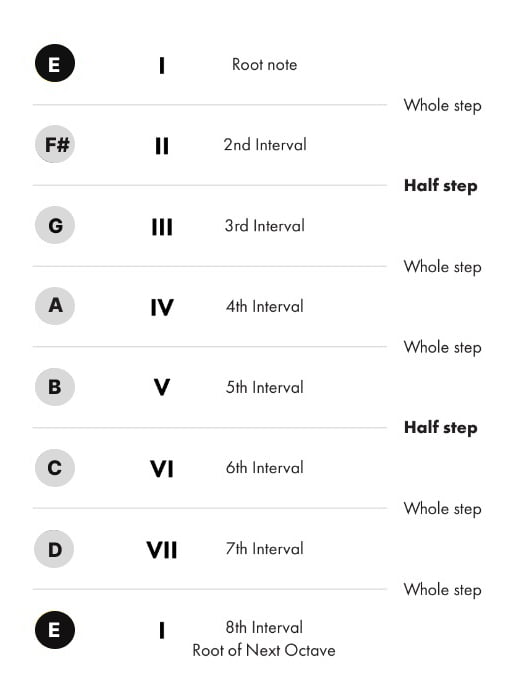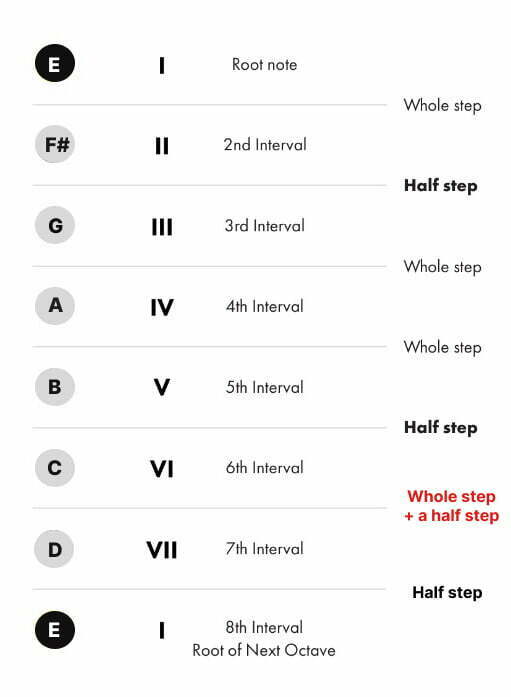What is a Minor scale on Guitar?
Minor scales have a melancholic and dramatic tone, in contrast to the upbeat and cheerful sound of major scales. Learning to play minor scale can add new dimensions of sound and emotion to your playing. Practicing scales can help you develop an ear for notes, improve your fretwork speed and precision, and enable you to play your favorite songs while providing the building blocks to create original music.
Before delving into the musical theory behind minor scales, it's essential to understand the mechanics of scales. Every scale, whether major or minor, comprises a sequence of seven notes in ascending or descending order. The eighth note is a higher or lower version of the first (root) note that bookends that octave.
With the basics of scales covered, let's learn more about the various types of minor scales!
Types of Minor Scales and Intervals on Guitar
Minor scales come in several different types, with three of the most common being:
- Natural minor
- Harmonic minor
- Melodic minor
This lesson covers each of these three scale types and the formulas used to play them in any key. To build these scales, you'll need to examine the intervals between each note on the scale. Intervals refer to the difference in pitch between two adjacent notes, which can be a whole or half-step, or in some cases, one-and-a-half steps.
Natural minor scale
The natural minor scale is the simplest of the three minor scales. It employs notes in a given key without modifying the key signature. To play the natural minor scale starting from the 1st (or root) note of a scale, you would use this formula with the following intervals:
• Whole step• Half step • Whole step• Whole step• Half step • Whole step• Whole step
For instance, let's take a look at the E natural minor scale as an example of a natural minor scale.

Harmonic minor scale
The harmonic minor scale is more challenging to play compared to the natural minor scale. It produces a slightly different sound as it rises in pitch towards the end of the octave. This is due to the raised 7th note that goes up in tone by an additional half-step. To construct a harmonic minor scale, you would start with the 1st (or root) note of a scale and follow this formula:
• Whole step• Half step • Whole step• Whole step• Half step • Whole step + a half step • Half step
For example, if you were playing an E minor natural scale, the seventh note of your scale would be a D. However, if you were playing an E minor harmonic scale instead, you would raise that 7th note by an additional half-step, making it a D#. The "sharp" signature in D# indicates that you would raise it by a half-tone.

Melodic minor scale
The melodic minor scale is considered the most challenging of the three minor scales. To construct a melodic minor scale, you would start with the first (or root) note of a scale and follow this formula:
• Whole step• Half step • Whole step• Whole step• Whole step • Whole step + a half step • Half step
The formula for the melodic minor scale is played with the 6th and 7th notes each going up an additional half-step as the notes ascend. For instance, if you were to play the E minor as a melodic scale, your 6th interval would be a half-step higher than usual (C#), and your 7th interval would also be a half-step higher (D#).

It is crucial to understand that the melodic minor scale pattern is used only when playing notes in an ascending order. When playing notes in a descending order, you should switch back to the natural minor scale pattern that we discussed earlier in this article.
More minor scales on guitar
Now that you have a basic understanding of some of the commonly used minor scale patterns, you can expand your knowledge by learning more about other minor scales. Each free lesson will provide you with information about the notes and musical theory related to a specific scale, as well as a few different positions where you can play it. Some of the minor scales you can learn include: A Minor Guitar Scale, B Minor Guitar Scale, C Minor Guitar Scale, D Minor Guitar Scale, E Minor Guitar Scale, E Harmonic Minor Scale, and G Minor Guitar Scale.
Playing guitar is a skill that takes time to develop, so it's important to be patient and persistent. Learning minor guitar scales can help you improve your guitar skills and explore new ways of playing your favorite songs. It can also inspire you to create your own music and experiment with guitar solos.
Once you have practiced playing the E minor scale and feel comfortable with it, you can access additional lessons Keep learning and playing by checking out our Guitar tunio everyday








